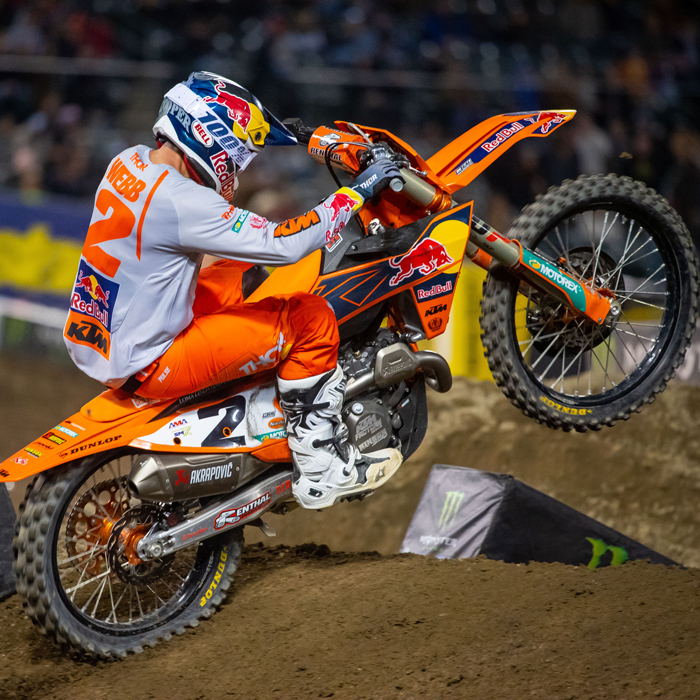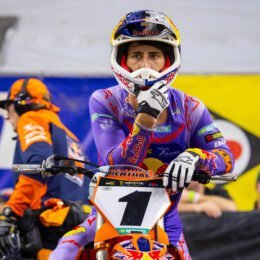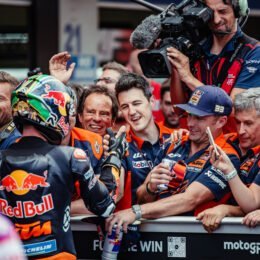FROM THE DEEPEST RUT TO THE STADIUM FLOOR
Huge jumps and hard pack mean that AMA Supercross is a tough test of dirtbike suspension, but just how different is it to motocross and a conventional dirtbike setting? We pushed WP Suspension for some answers…
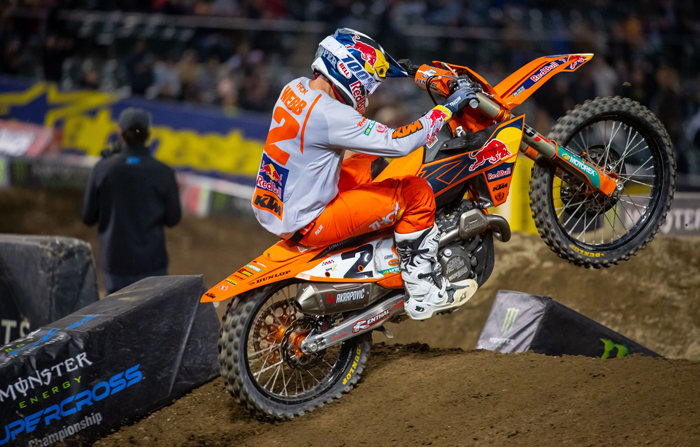
PC @ALIGN MEDIA
Push down the seat of any normal dirtbike and you’ll feel an encouraging bounce. The motorcycle is ready for bumps, whether in a local woodland or across a motocross racetrack. Try the same thing with a machine primed for all the jumps, speed and height of supercross and the reaction is quite different. It’s as stiff as a board.
Considering very few people in the world can race supercross to a decent standard, the configuration is something of a mystery to many regular dirtbike riders. AMA Supercross bikes (which have to adhere to strict production rules) are geared differently, have some tougher components – like elist-strength wheel rims and hubs to cope with the big jumps and rhythm sections – and the engine delivery is also tweaked but the suspension is arguably the biggest variation. It needs to be harder and more rigid but also ready for maximum grip across slick surfaces and jump faces.
It’s unlikely many of us will ever really experience what a supercross bike is like, so in search of some context we spoke to WP Suspension’s Martijn Hendriks (Development Technician) and Adam Walters (Suspension Manager) – who both fettle the Red Bull KTM Factory Racing machinery of Marvin Musquin, Aaron Plessinger, Tom Vialle, Max Vohland and Cooper Webb – at the Houston round of the 2023 AMA series to ask…

PC @ALIGN MEDIA
Guys, are supercross settings really ‘night and day’ different to what people might normally experience with a dirtbike and for motocross?
Martijn: I would say that Enduro has more in common with motocross than supercross has with motocross in terms of setup.
Adam: I totally agree. If you are trying to ride supercross with a motocross setting then you are not in the right place.
So, a supercross bike is almost a pain in the ass – literally – to ride? Not much comfort there…
Adam: We always say: ‘you can drive a Ferrari or you can drive a Cadillac’. For sure it is going to have to be stiff and less comfortable for things like braking bumps and some other areas of the track but then the rider gains more for the jumps, whoops and in the corners.
Martijn: But there is still some comfort with a supercross setting. When we started with Tom [Vialle, MX2 world champion and 250SX supercross rookie for 2023], who had never really ridden a supercross setting until this year, he was still surprised with how much movement there was and the feel for the tires.

PC @ALIGN MEDIA
How about development of a new suspension system or hardware? Is it better to put it through tests in motocross or supercross? Or are the two sports too different?
Adam: The good thing about supercross is that you can learn something that you know will become a good option for motocross. Obviously not everything translates because the setting is so much stiffer but a style of supercross setting – tamed down – could be a good direction for motocross.
Martijn: I think the equipment takes more of a beating in motocross than supercross. In supercross the rider is more precise, the damping controls a lot of the movement. In motocross, if you have a guy going flat-out into a set of gnarly braking bumps then everything is being tested. It is a lot more aggressive on the kit.
Adam: Plus, motocross is longer. There is more riding…but we shouldn’t really have any problems in either sport. If we do then something really needs to be changed.
Martijn: The main hardware – the fork and the shock – are the same but the internals, with the springs and the actual settings, are changed. The fork that Jeffrey [Herlings] won his MXGP championship with in 2021 is the same that Cooper [Webb] used to win supercross the same year. The same for the shock. The packaging could be different…but the hardware comes from the same drawing.
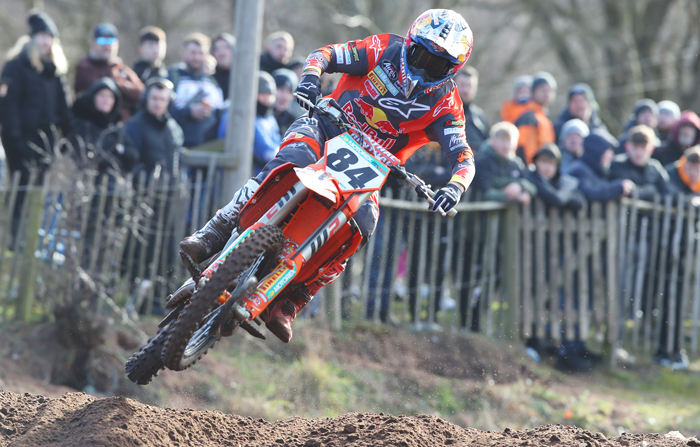
PC @Pascal Haudiquert
Motocross racers will spend time testing to make a base setting for the season. Is that process the same for supercross? Does it take less time or more?
Adam: It’s a shorter process simply because they don’t have time. Most of the 450 guys will not start motocross testing until April. We have one weekend off and we might be able to squeeze in some riding then but if someone is involved in a championship fight then it will get left until the end of the supercross season. It’s really hard. They have been riding a really stiff setting for a long time so that transition to motocross is a little awkward. They’ve had a very firm bike for months and you have to watch that you don’t go too soft for motocross and go over the limit. They are riding supercross almost eight months a year now.
So supercross and that type of suspension is almost parallel to road racing, to some degree…
Martijn: One similarity is the consistency of the laps. A supercross test track will probably have a line that is 30 cm wide and will be hit lap-after-lap. If you want to run data acquisition and telemetry in general then supercross gives you more repetition; more than motocross. A motocross sand track will shift enormously in five laps and the bike will react differently as you change lines.
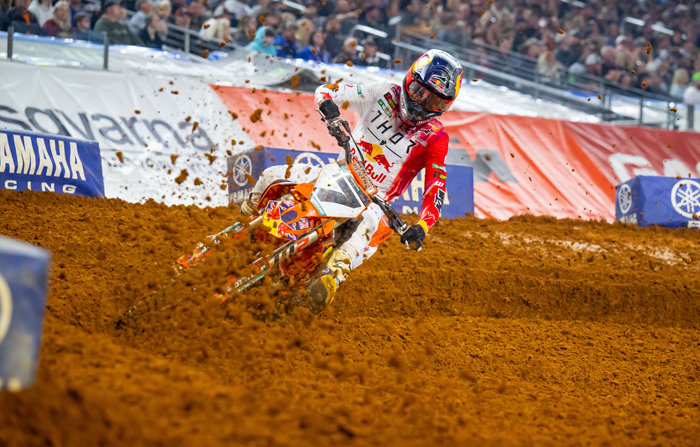
PC @ALIGN MEDIA
What about changes to the settings at a race? Are riders making more at a supercross events or at a motocross round?
Adam: It depends where the rider is in terms of feeling.
Martijn: He needs to be ‘in the window’ [of optimum performance]
Adam: If he is not in the window and he is chasing then you are throwing everything at it. If we do our homework then you don’t end-up in that situation.
When KTM change the technical concept for the bike – like they did with the KTM SX-Fs for 2023 – then does this mean an interesting new challenge for you guys?
Adam: We should always be looking for new stuff, whether it’s a new bike or older one that has already been developed quite a lot. If we are not pushing to go that extra distance then we will be left behind. A new bike is always a bit more difficult because you don’t know all the features and potential whereas an older package is far more familiar: you know what changes to make and what they will mean for the rider. As suspension guys we are not always going to be right all the time anyway; there is always some trial and error involved.

PC @ALIGN MEDIA
For the technical side, what’s more enjoyable? Supercross or motocross?
Adam: For me I want to do good in both!
Martijn: After some time working on the supercross setting you look forward to motocross and then vice-versa! Both have their own challenges.
Is motocross more appropriate for development?
Adam: Yes, but there are some things and parts that filter out of supercross to motocross. There is some learning there.
Martijn: There is a lot of information shared between supercross and MXGP. If we find something good in Europe then the guys in the USA will know the next day. The two [WP Suspension] teams have two different outlooks and environments but they really complement each other.
What’s the next boundary for supercross suspension development?
Martijn: We are bound by the rules to a degree. Electronic suspension is out of the question…otherwise that would be the next big frontier.
Adam: Sometimes I think ‘we cannot really do much more with what we have’…but then you look at your notes five years previously and you would never have thought that you’d reach where you are now! It’s a strange evolution. You get to a stage where you think ‘we’re pretty good’ but then you get a couple more ideas and you go further. Over time it’s unbelievable where you have arrived.
An example?
Martijn: For both supercross and motocross then it is pure damper stiffness. If you look at a supercross race from, say, the 1990s then I think MXGP is riding stiffer suspension now than those guys were! It gives you an idea of where we came from.
Adam: The speeds are only going up. The bikes are faster, the riders are fitter and are pushing more. It keeps elevating. They go up and we follow with the setting. We keep finding solutions.
Martijn: And our combinations are infinite, and that’s the biggest challenge. An engine guy might find more horsepower or more torque and that’s a good direction for the bike or the project but for us, if we put more or less damping or change the curve in any way then that’s no guarantee that it might be better or worse. You keep searching for that little advantage. Everybody does.

